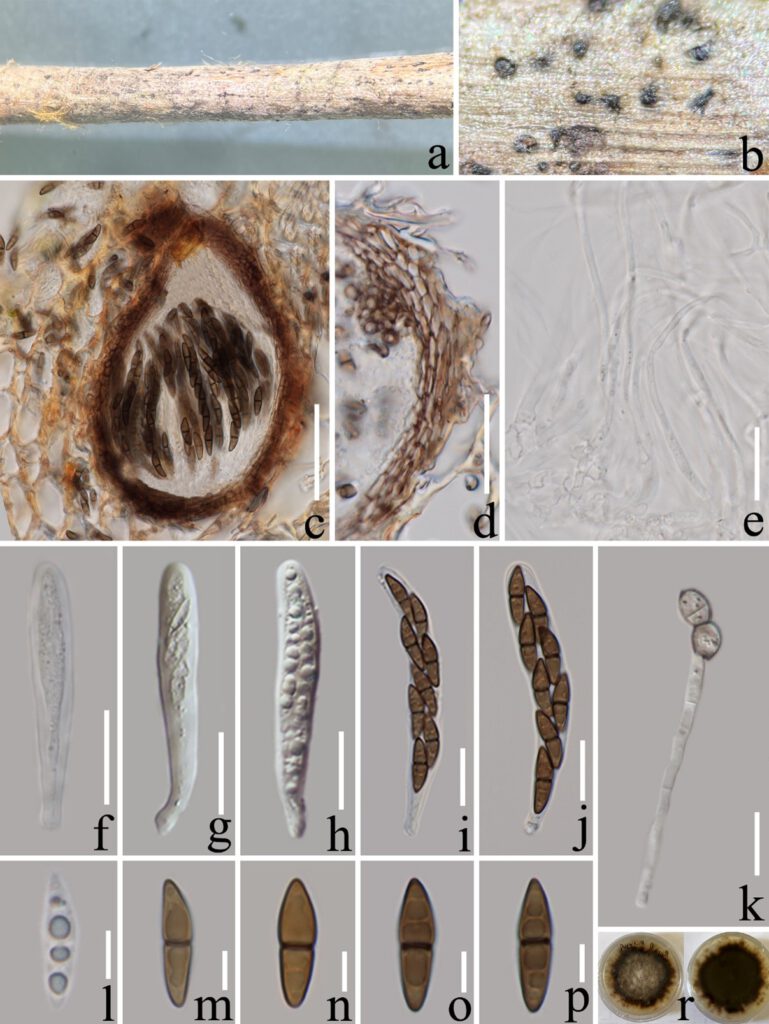Nigrograna puerensis L. Lu, K.D. Hyde & Tibpromma, sp. nov. (Figure 3)
MycoBank number: MB; Index Fungorum number: IF; Facesoffungi number: FoF 12766;
Etymology: The specific epithet “puerensis” refers to the Pu’er City, Yunnan Province, China where the type species was collected.
Holotype: ZHKU 22-0122
Saprobic on decaying branch of Coffea arabica. Sexual morph: Ascomata 90–180 µm high, 90–150 μm wide (x̅ = 138×115 μm, n = 10), immersed, with only ostiolar necks visible on the host surface or erumpent, normally solitary, subglobose to elliposid, dark brown. Peridium 10–15 μm thick (x̅ = 13 μm, n = 15), outer layer consists of 2–3 layers of textura angularis, dark brown and thick-walled cells, inner layer hyaline with thin-walled cells. Hamathecium composed of numerous, 1.5–2 µm wide (x̅ = 1.8 μm, n = 20), flamentous, hyaline, septate pseudoparaphyse. Asci 50–80 × 8–11 μm (x̅ = 66 × 9.5 μm, n = 20), 8-spored, bitunicate, fissitunicate, cylindrical to clavate, short pedicellate, apically rounded, with poorly developed ocular chamber. Ascospores 15–18 × 4–5 μm, (x̅ = 16 × 4.5 μm, n = 30), uni- to bi-seriately arranged, fusoid, apical cell and basal cell acute, and apical cell slightly wider than basal cell, straight or slightly curved, 1-septate, constricted at septum, guttulate, hyaline to yellow-brownish when young, brownish at maturation. Asexual morph: Undetermined.
Culture characteristics: On PDA, colonies reached up to 4 cm diam. after two months at room temperature (22–26℃). Colony dense, circular, slightly raised at the center, surface with white aerial mycelium, fluffy, with serrate edge, grayish to dark brown from center to edge, reverse dark green to dark brown.
Material examined: Pu’er City, Yunnan Province, China, on decaying branch of Coffea arabica, (101°0’59”, 22°36’2” N, 1016.43 m), 16 September 2021, LiLu, Puer 1-4 (ZHKU 22-0122), ZHKUCC 22-0212 = ZHKUCC 22-0213. GenBank number; ITS: ***, LSU: ***, SSU: ***, tef1-α: *** (ZHKUCC ***); ITS: ***, LSU: ***, SSU: ***, tef1-α: *** (ZHKUCC ***).
Notes: Nigrograna puerensis clusters with N. carollii with significant statistical support from ML 100% and BYPP 1.00. In morphology, our new taxon best fits the genus Nigrograna by having immersed ascomata, clavate and short pedicellate asci, and pale to brown, fusoid to narrowly ellipsoid, and septate ascospores (Jaklitsch & Voglmayr et al. 2016, Zhang et al. 2020). Blast search results of ITS, LSU and tef1-α sequence data revealed that our taxon is similar to N. mackinnonii (96% MZ270697, 99% KJ605422, 95% LT797087 respectively), while the similarity of SSU sequence to N. carollii is as high as 99%. Unfortunately, for N. carollii sufficient morphological data are not available to compare with our novel taxon which was isolated as an endophyte on living sapwood of wild Hevea brasiliensis and N. mackinnonii which was isolated as a human pathogen (de Gruyter et al. 2012, Kolařík et al. 2017). Therefore, based on morphological and phylogenetic analyses, we introduce N. puerensis as a distinct new species.

Figure 3. Nigrograna puerensis (ZHKU 22-0122, holotype). a, b Ascomata observed on host substrate. c Vertical sections through an ascoma. d Cells of peridium. e Hamathecium. f–j Asci. k Germinating ascospore. l–p Ascospores. r Colonies on PDA. Scale bars: c = 50 μm, d = 30 μm, e–k = 15 μm, l–p = 5 μm.
